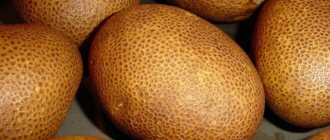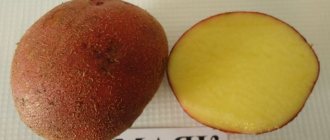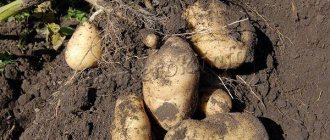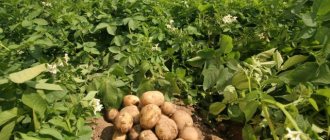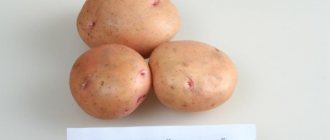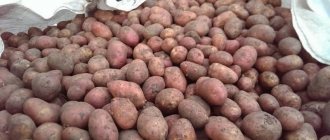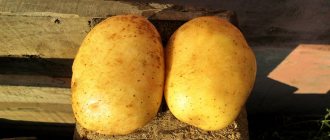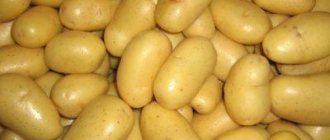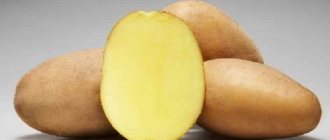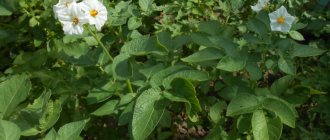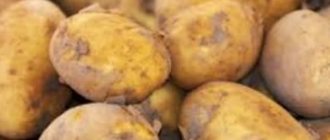Description of the variety
The popularity of the Ryabinushka variety is caused by its positive qualities, which elevate it to the rank of elite.
This is what potatoes look like in the photo:
Origin and development
The Ryabinushka variety appeared and was included in the state register of the Russian Federation in 2007. It was bred by breeders of the Vsevolozhsk Potato Breeding Station (Leningrad Region). Based on the sum of its merits, the variety is classified as elite and super-elite .
Over the years since its appearance, the variety has managed to spread throughout Russia and within the borders of the former USSR.
Chemical composition, trace elements and vitamins
The chemical composition of potatoes depends not only on the variety, but also on the composition of the soil, weather conditions, agricultural technology , Even the starch content of the same variety can vary widely - from 11 to 18%.
But, without resorting to chemical analysis, something can be determined even by the appearance of the potato :
- the red color of the peel means that the potato is rich in anthocyanins - substances from the group of bioflavonoids that strengthen the walls of blood vessels and have antioxidant properties;
- The creamy color of the pulp indicates a high content of beta-carotene.
In addition, potatoes of the Ryabinushka variety contain:
- water – 76.3%;
- dry matter - 23.7%;
- starch – 17.5%;
- sugar – 1%;
- fiber – 1%;
- protein – 2%;
- ash – 1%;
- organic acids – 0.7%.
The culinary use of the Ryabinushka variety is universal .
Ripening period
The period of ripening of mountain ash to technical ripeness is 80-90 days . You can dig it up for consumption 10-15 days earlier.
Productivity
The yield indicators of Ryabinushka are at the level of the best elite varieties : with a seeding rate of 27-29 kg, it can produce up to 400 kg per hundred square meters or up to 40 tons per hectare! At the same time, the marketability of the variety can reach 96% - that is, defects, waste and substandard conditions will amount to no more than 4%.
Disease resistance
There are no potato varieties that are universally resistant to all diseases and pests. However, the Ryabinushka variety has good immunity against many diseases , and is very resistant to potato cancer and the pest - the golden nematode.
Attention! The variety is susceptible to late blight.
Appearance and characteristics of tubers
The bush is of medium height, the stems are erect or slightly spreading .
The leaves are dark green, wavy, tapering towards the top. The flowers are violet-blue. After flowering, fruits are formed - “balabolki”.
The skin of the tubers is thin, smooth, pink, sometimes (with a high anthocyanin content) with a crimson tint. The tubers are even, oval, smooth, with small eyes.
The average weight of a potato is 90-130 g, size is from 30 to 55 mm . The pulp is yellow, creamy, not darkening.
For which regions is it best suited?
Rowanushka is a variety with a ripening period of 80-90 days. Therefore, it is perfect for those regions of Russia that cannot boast of long and warm summers .
This variety is recommended for cultivation in the Northern, Northwestern, Central Black Earth, Volga-Vyatka regions of Russia, the Volga region, the Far East and Western Siberia.
In the territory of the former USSR, the variety is zoned in Belarus, Ukraine and Moldova .
Protection from diseases and pests
Prevention
The variety is resistant to diseases. Can resist potato cancer and potato nematode.
Moderately resistant to late blight. Late blight is a disease of the potato bush caused by a fungal infection.
Outwardly, it is quite easy to notice the disease: dark brown spots appear on the leaves, and a dark coating appears near the stem of the trunk. The plant becomes lethargic and begins to die quickly.
The simplest method of prevention is spraying plants with a solution of copper sulfate. The solution is prepared in the following proportion: 5 liters of water: 5 grams of vitriol.
As a preventative measure, planting material is treated by soaking it in onion broth for 7-9 hours before germination.
A classic problem with any potato crop is the Colorado potato beetle. To destroy the insect, they use “Killer”, “Karate”, “Iskra”, “Fastak”, “Prestige”. The proportions and processing technique can be read on the packaging of the drug. During the first two days, the insects die.
The main advantages and disadvantages of the variety
Ryabinushka potatoes are distinguished by their harmonious combination of many advantages that are inherent in other varieties only individually :
- undemanding to soil type and growing conditions;
- high productivity;
- tuber alignment;
- good immunity against diseases;
- resistance to golden nematode;
- good keeping quality;
- good resistance of tubers to mechanical damage (suitable for industrial processing);
- great taste.
The disadvantages of the variety include:
- susceptibility to late blight;
- reduction in yield under extreme conditions: drought or heavy rain;
- the sometimes noted tendency to degeneration - which sometimes serves as an excuse for illiterate agricultural technology.
Other potato varieties:
High-yielding potato variety "White Swan"
Mid-early potato variety Charodey
Early table potato variety "Tiras"
Pros and cons of Ryabinushka
Over the years of cultivating this variety, gardeners have been able to highlight a number of its main advantages. These include:
- Rapid ripening of tubers. Already 3 months after planting, you can harvest.
- High yields. Even in unfavorable conditions (but with care) they get up to 220 centners per hectare. Under good growing conditions, you can easily get up to 400 centners of marketable tubers from 1 hectare.
- Root vegetables have a pleasant taste.
- Has high levels of immunity. Less susceptible to late blight than many other popular varieties.
- Tubers can easily be transported over long distances, which greatly simplifies trade.
However, it is worth mentioning the disadvantages. If you evaluate the reviews, you can understand that Ryabinushka is more demanding of watering than other varieties. Also, the percentage of preservation of tubers in winter is in the range of 90%, which is several times lower than that of similar, mid-early varieties.
Features of planting and growing
Agrotechnical methods for growing the Ryabinushka variety are traditional .
Preparing for landing
About a month before planting, potatoes should be started for germination . It is most rational to use potatoes approximately the size of a chicken egg, with an average number of eyes.
Reference. Planting potatoes with tubers is a vegetative, not seed, method of propagation. Therefore, the size of the planted tuber, contrary to what is sometimes expressed, cannot in any way influence the size of the future harvest or any deviations from its varietal characteristics.
Selected tubers are laid out in one layer in boxes or on matting and left in the light at a temperature of about +20°C. After about 5-7 days, the first shoots should appear.
After this, the seed material is removed to a cool place (10-12°C) until planting.
Before planting, tubers for disinfection should be pickled in a solution of copper sulfate . Methods for preparing the mixture:
- copper sulfate – 20 g, potassium permanganate – 1 g, water – 10 l;
- copper sulfate – 5 g, boric acid – 10 g, potassium permanganate – 1 g, water – 10 l.
If tubers are cut into pieces for planting , then after each cut the knife should be dipped in a solution of copper sulfate, and the cut should be sprinkled with wood ash.
Soil requirements
The Ryabinushka variety is not very demanding on the composition of the soil, but prefers areas with fertile light soil - sandy loam.
Fertilizers, including organic ones, are applied in the fall , during plowing or digging.
The best predecessors are grains or legumes: peas, beans, as well as perennial green manure grasses - alfalfa, lupine.
Dates, scheme and rules of planting
The timing of planting the Ryabinushka variety is the same as for planting potatoes, traditionally accepted in a particular region.
In central Russia, they usually fall on the May holidays, when the onset of warm weather conveniently coincides with several non-working days. Planting pattern :
- square-cluster method with a distance between holes of 25-30 cm;
- in rows with a distance between bushes of 25-30 cm and a row spacing of 50-70;
- The seeding rate per hundred square meters is 27-29 kg, that is, about three buckets of seed potatoes.
A hole is dug half the length of a shovel (about 10 cm), seed potatoes are laid, if possible, half a ladle of wood ash is added, sprinkled with earth and leveled.
On light to medium soils, you can get by with just one shovel and rake . On heavy and clayey soils, a walk-behind tractor will be a good help, and in this case it is more profitable to plant potatoes in ridges.
Features of cultivation and nuances of care
Growing potatoes of the Ryabinushka variety has no specific features and is carried out according to standard rules.
Watering
In hot weather or prolonged drought, when there has been no rain for more than a week , Ryabinushka, like any variety of potato, requires watering. The most convenient way to water potatoes is with a hose, directing the water along the rows. When watering a small area with a watering can, the approximate norm is one bucket per square meter. m. Watering is done once a week in the evening.
Loosening
Loosening of row spacing should be carried out once a week , the day after watering or (unscheduled) after heavy rain.
Weeding and hilling
Weeding is usually combined with loosening . In the first half of the growing season it is carried out 1-2 times a week, in the second half - once a month.
Hilling - at least twice per season: the first - at the end of May, when the shoots reach 10-15 cm, the second - at the beginning of flowering. After heavy rains, when the ground around the bushes settles, additional hilling may be required.
Top dressing
variety accepts both mineral and organic fertilizing well .
First feeding : at the germination stage. Approximate composition:
- Urea – 1 tbsp. l., water – 10 l.
- Mullein – 0.5 l, water – 10 l, leave for 3-5 days.
- Chicken manure – 0.5 l, water – 15 l, leave for 3-5 days.
Consumption – 0.5 l per bush.
Second feeding : at the stage of bud formation. Ingredients: potassium sulfate - 1 tbsp. l., wood ash – 1 tbsp., water – 10 l. Consumption – 0.5 l per bush. This fertilizing accelerates the onset of flowering.
Third feeding (during flowering): superphosphate – 2 tbsp. l., mullein - 1 tbsp., water - 10 l. Consumption – 0.5 l per bush.
Attention! Concentrated fresh droppings can burn potatoes. It must be diluted with water and kept for several days.
Disease and pest control
The main attack on potatoes is the Colorado potato beetle . In a small area, it can be collected manually or, in case of severe infection, chemical insecticides “Decis”, “Aktellik”, “Karbofos”, etc. can be used.
When potatoes are affected by fungal diseases - scab, late blight, Alternaria blight, etc. – after an accurate diagnosis of the disease, fungicides “Quadris”, “Uniform”, “Shirlan” or similar are used.
Important! Any chemical preparations are used strictly according to the instructions supplied with the preparation, in compliance with all necessary safety measures. Harvesting in this case is possible no earlier than 20-30 days after treatment.
Prevention:
- Treating tubers before planting with Tirana and Maxim products will help prevent the appearance of the Colorado potato beetle.
- For the prevention of diseases, incl. late blight, tubers are treated with copper sulfate before planting.
- Only healthy tubers should be used for planting.
- In order to repel pests, it is worth planting strong-smelling plants, aromatic herbs, and calendula in the rows.
- A universal preventive measure is strict adherence to crop rotation.
Care for Rowanushka
The variety is unpretentious in cultivation and care. To obtain a generous harvest, it is necessary to properly prepare the site, planting material and carry out proper care.
Rowanushka potatoes are planted in well-warmed soil after the end of spring frosts. The planting area should be well lit and protected from gusty winds. The best predecessors are:
- cucumbers;
- cabbage;
- beet;
- greenery;
- legumes and cereals.
After tomatoes, peppers and eggplants, Ryabinushka potatoes cannot achieve a good harvest.
Chernozem, loamy and sandy soil are suitable for planting potatoes. Clay soil is very heavy, so sand and humus are added to it during digging.
Seed material is prepared in the fall. To do this, seed potatoes the size of a chicken egg are selected and kept in the sun until a green coating appears. This vegetable will last until spring and will not be spoiled by rodents.
A month before planting, the tubers are germinated. They are transferred to a box and put away in a warm, well-lit room. After 10 days, sprouts appear. When they reach 3 cm, the potatoes, weather conditions permitting, can be planted. If the temperature is low, the sprouted potatoes are put in a dark place.
Before planting, the tubers are treated with Zircon or Epin. If seed potatoes are purchased in a store, they must undergo additional treatment against fungal diseases. To do this, the tubers are placed in warm water or a 0.1% boric acid solution for half an hour.
Landing rules
Planting potatoes is not a difficult task. It doesn't take much time or effort. Yield depends on compliance with the rules:
- In the spring, after the end of spring frosts, the beds are dug up and filled with urea.
- It is better to make ridges in the direction from north to south with an interval of 80 cm.
- Potatoes are placed in a hole to a depth of 6-10 cm, the distance between holes is maintained at 30 cm.
- When planting, each hole is filled with wood ash and covered with a small layer of nutritious soil.
- Place potatoes on top, sprouts up.
- The holes are filled with earth so that ridges 10 cm high are formed.
Watering and fertilizing
To obtain a generous harvest, potatoes require regular watering. The frequency of irrigation depends on climatic conditions and the growing region.
Proper watering of potatoes:
- 14 days after planting, when the seedlings grow by 10-15 cm;
- during the appearance of flower ovaries, when tubers begin to form;
- with intensive tuber formation.
For rapid growth and development, Rowanushka potatoes need 3 feedings per season.
- When the plant reaches 15 cm, nitrogen fertilizers are used for this. Fertilizing must be applied strictly according to the instructions, since if there is an excess of nitrogen, the plant will begin to grow green mass to the detriment of the harvest. If the planting material is planted in nutritious soil, the first feeding can be abandoned.
- At the moment of formation of the ovaries. Phosphorus-potassium fertilizers are used for feeding. For better flowering, add 1 tbsp to a bucket of water. ash and 1 tbsp. l. potassium sulfate.
- A month before harvest. Mineral and organic fertilizers are used as fertilizer. Per 10 liters add 30 g of superphosphate and 250 ml of slurry. Half a liter of fertilizer is used per bush.
Loosening and weeding
After each watering, loosening and weeding are carried out. Regular removal of weeds will protect the plant from diseases and pests.
Loosening will provide quick access of oxygen to the roots. Under the earthen crust, the tubers stop developing and begin to dry out. The first time the soil is loosened before emergence, on the 6th day after planting. Further loosening is carried out as necessary.
Hilling
In order for the tubers to grow quickly and develop well, the bushes must be hilled. This procedure:
- stimulates bush growth;
- improves oxygen access to roots;
- gets rid of weeds.
Hilling can be carried out in 2 ways: classic and fan.
Classic - the bush is covered with earth on both sides, raking a high mound onto the bush.
Fan - the soil is laid not on the side, but in the center of the bush. To do this, the tops are moved apart in the center and covered with earth, grass or straw. This method does not look as beautiful as with classic hilling, but the yield increases almost 2 times. The procedure is carried out early in the morning or after sunset, not forgetting to water the bushes generously.
If the summer is hot and frequent irrigation is not possible, it is better not to do hilling. Since the dryness and heat of the hilled bushes can cause potatoes to bake directly underground.
Caring for Rowanushka (and any potato) is as simple as 2x2. It is necessary to water the potatoes three times a season (sometimes a little more), hill them twice and fertilize them (not always).
Irrigation
Rowan is more demanding of watering than other varieties. But this does not mean that it will create additional discomfort for gardeners.
Potatoes need to be watered only 3-4 times per season (in too hot conditions, you can increase them by 1-2 more waterings).
The potatoes are watered for the first time after the tops appear, when they rise from the ground by 10-15 cm.
The second watering is carried out immediately after flowering begins. And the last watering, after its completion.
Experienced experts do not recommend watering the crop after flowering. Such an agrotechnical procedure can cause side effects in the form of acquired late blight fungus.
Hilling
Many gardeners neglect this procedure, not understanding its invaluable benefits.
Firstly, when we hill up potatoes, we automatically loosen the soil. It is saturated with oxygen, which has a beneficial effect on the harvest.
Secondly, hilling allows you to clear the area of weeds that have a depressing effect on the crop.
Thirdly, hilling keeps the tops from sticking to the ground, thereby protecting them from early drying out.
Rowanushka is spudded twice a season. The first hilling is carried out after the tops have risen by 20-25 cm. The second hilling is carried out as the green part of the crop grows (after approximately 14-20 days).
Fertilizer
If the soil is fertile enough, then potatoes do not need any fertilizers. On the contrary, excessive amounts of nutrients can negatively affect future yields.
The only fertilizing that must be carried out is autumn. In autumn, the area is cleared of weeds and crop residues. It is fertilized and loosened (digged/plowed). These fertilizers should be enough to grow a good potato crop.
If the soil is heavy and has a low nutrient content, then “direct” feeding can be done directly into the hole. Fertilizers are added directly when planting potatoes. A handful of wood ash or humus is added to each hole.
All measures for caring for the Ryabinushka variety are determined by climatic conditions, as well as the fertility of the soil in the growing area and the development phase of the plant. They begin to care for this variety a week after planting:
- It is necessary to remove all weeds with further loosening of the soil;
- After the growing season reaches the stage of bud formation, you need to ensure that the soil is kept moist and watered as necessary;
- Hill up twice a season, improving soil aeration and increasing the formation of tubers;
- If high-quality pre-planting fertilization of the soil with fertilizers has been carried out throughout the season, there is no need to fertilize the plantings, since excess amounts of certain substances contribute to the deterioration of the quality of the future harvest;
- To protect potato plantings from the most common and harmful diseases, as well as from insect pests, the plantings are treated with preparations such as “Prestige”, “Aktara” or “Confidor”.
For a good potato harvest, at least minimal care is absolutely necessary. Depending on climatic conditions and soil type, care may vary slightly. But basically it includes the following activities:
- Weeding is carried out either independently or together with hilling the bushes. Thanks to the destruction of weeds, the plant develops better and receives more nutrients from the soil.
- Hilling up - helps strengthen the potato bush and root system. Also, using this method, the earth is enriched with oxygen, weeds are removed and moisture is evenly distributed. During the entire period of vegetable growth, hilling is recommended to be carried out at least 2 times.
- Fertilizing is also necessary for good growth and development of potatoes. Applying fertilizers helps accelerate plant germination and the formation of tubers, and eliminates damage to potatoes by pests and diseases. Fertilizing is carried out with organic and mineral compounds.
- Pest and disease control begins even before planting potatoes, when the tubers are sprayed or soaked using special preparations. Subsequently, when the bushes have formed, you can manually collect Colorado potato beetles and also spray the plant against various insects.
Fertilizer
Harvest and storage
Growing a good harvest is half the battle. It is also important to properly remove and store it.
How and when to collect
The usual time for harvesting potatoes in the middle zone is the first half of September . Other rules include:
- Harvest in dry and sunny weather.
- The dug up tubers are scattered in one layer in the sun for 2-3 hours to dry.
- Next, the tubers are removed under a canopy or in a ventilated room for 10-14 days for “quarantine”.
- After this, the tubers are finally sorted out and stored in a cellar or dry storage. For better preservation, they can be dusted with dry wood ash.
- In parallel with this, you can select seed material for planting next year.
Storage features and keeping quality of the variety
The optimal storage temperature for the Ryabinushka variety is 3-4°C . At this temperature, its shelf life is quite satisfactory - the percentage of spoilage by spring does not exceed 10%.
Advice from experienced gardeners and reviews about the Ryabinushka variety
Feedback from farmers about the Ryabinushka variety is generally positive.
Timur, Saratov: “The variety, in my opinion, greatly depends on the year - in the heat or rainy season the tubers become smaller.”
Alexandra, Volzhsk : “The Ryabinushka potato variety is a very rational variety. All tubers are the same size, there are few small things. There are no problems with preparing seed material.”
Nikolay, Novgorod : “Ryabinushka perfectly accepts feeding with fresh chicken droppings. I carry it out once a season, while the bushes are below 15-20 cm. It makes no sense to feed overgrown plants, since this no longer affects the size of the tubers.”

